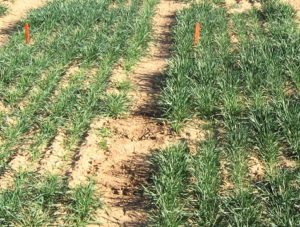What to do when it doesn’t rain
 by Emily Cates
by Emily Cates
I’m sure you’ve noticed it for a while: brown patches on the lawn, wilted leaves on garden plants, dusty soil, and wild animals of all sorts sighted in unusual locations in an earnest quest to find water. Usually by now there’s an abundant harvest in the garden waiting for our attention. This year, though, the harvest seems sparse and late. There’s no denying it – we need some rain!
While I’ll try not to be all doom-and-gloom in this article, there are a few tactics we can employ to make the best of our gardens during a drought. We’ll look at methods of water conservation and water-saving modes of irrigation. And we’ll examine a few plants that aren’t, surprisingly, as fazed and will still produce deliciously without a lot of rain. For more information, check out this helpful article from Cornell: http://emergencypreparedness.cce.cornell.edu/disasters/Documents/Hort%20225%20Gardening%20Under%20Drought%20Conditions%20Jan%2004.pdf
The first thing we want to keep in mind is what our priorities are. Most plants (especially newly-planted trees, shrubs, and annuals) need about an inch of water a week. Is there a rare or  expensive specimen that is a clear candidate for supplemental watering? Are there trees that were planted within the last few years? Well then, by all means, these should be watered. Plants with adequate moisture around their roots will not become stressed from a lack of water, and then, in turn, will be more resistant to pests and pestilence in future years.
expensive specimen that is a clear candidate for supplemental watering? Are there trees that were planted within the last few years? Well then, by all means, these should be watered. Plants with adequate moisture around their roots will not become stressed from a lack of water, and then, in turn, will be more resistant to pests and pestilence in future years.
There are a few tricks, though, to maximizing the efficiency of watering: First, get rid of weeds, which steal water from desirable plants…. but don’t spray herbicides or fertilizers during a drought – since they will burn plants. After weeding, apply a thick organic mulch of straw, aged sawdust or wood chips, or similar materials. (The best part about mulch is that it can conserve around 90 percent of the moisture in the soil!) Then water deeply until the soil around the roots is saturated. It’s better to water deeply once or twice a week, rather than to sprinkle lightly daily. Water in a cool part of the day when the wind is still to prevent evaporation. Remember, too, that raised beds and mounds tend to dry out quicker than standard rows. (My squash plants planted in a manure pile at the far end of the garden need daily watering. Let’s hope they produce a whole bunch of fruits to make it worth it!)
Better yet, use drip irrigation. This low-cost system of watering uses perforated hoses buried in the ground or under mulch, and takes the water to where it is needed – the roots. Since the moisture goes right to the soil, there is minimal risk of evaporation that commonly occurs with overhead watering and sprinklers. Drip irrigation does not need high pressure to operate; in fact, it can be as simple as a hose running from an elevated 5-gallon bucket full of rainwater. Recycled or relatively clean surface water can be used whenever possible. If the perforated hose is installed with the holes facing upwards, there will be less of a chance of it clogging. Drip irrigation is a great choice for both standard and container gardens, and is incredibly efficient. Do consider this as an option in your garden and orchard if possible, as it is well worth the effort and minimal expense.
Another thing to keep in mind during a drought is our lawns. Which, by the way, will be much happier and better-looking if we don’t mow when it’s dry. If the temptation to mow is irresistible, try only mowing after it rains.
Also, try to put off pruning for a less water-stressful time. Dead and diseased branches are fine to prune, but hold off on pruning otherwise – since pruning stimulates new growth that is especially drought-susceptible. Deadheading flowers, however, is a good idea. Spent flowers suck up needed water and should be removed. Plus, they look prettier this way.
Now, for the good news! Some plants don’t mind a lack of water, or tolerate it better than others. Raspberries, for example, aren’t so bothered and seem – in my garden anyways – to boast sweeter fruits and have less problems with diseases. Same goes for garlic: I made sure to mulch it like crazy and keep it weeded, and it surprised me unexpectedly this year. Despite me insisting on not watering it, my garlic rewarded me with healthy, delicious bulbs of good size. (By the way – if you’re reading this and you haven’t harvested your garlic, do it now!) The cherries, hazelnuts, cabbages, beans, peppers, carrots, kale, peas, herbs, and onions in my garden all seem to be OK without supplemental watering, too. The plums, tomatoes and cucumbers, on the other hand…
Well, I hope this helps. Eventually, it will rain – hopefully sooner than later and in the right amounts.
Responsible journalism is hard work!
It is also expensive!
If you enjoy reading The Town Line and the good news we bring you each week, would you consider a donation to help us continue the work we’re doing?
The Town Line is a 501(c)(3) nonprofit private foundation, and all donations are tax deductible under the Internal Revenue Service code.
To help, please visit our online donation page or mail a check payable to The Town Line, PO Box 89, South China, ME 04358. Your contribution is appreciated!


Leave a Reply
Want to join the discussion?Feel free to contribute!